I actually didn't make it to NAB this year. I was in Vegas on Friday, but the show ended on Thursday, which was painful for me. However I have been anxiously following the product releases, paying special attention to the "prosumer" and professional market of high-end HD camcorders, and solid-state memory systems. Unless you are a mechanical engineer with extensive film and video experience, I'm not going to believe you if you tell me that you understand the differences between such mind boggling format specifics such as 1080i, 720p, 30p, 24p, 3:2 pull (for 24p), 3:2:2:3 pull (for 24pA), HDV, DVCpro HD, 1080/60i, 1080/24p (over 60i), and so on...However, it is our job to understand this stuff, so that's what we are doing here. In a perfect video-world we would all shoot in 4k 10bit, uncompressed true 24p or 30p as if each video frame were a frame of actual film stock. My theory is that pretty soon we will (I guess we could be if we were all shooting with Viper Filmstreams or Arriflex D-20's), but until then we will have to settle with the slews of shooting HD on DV.
So going back to NAB, here is a list of the products that I am excited about: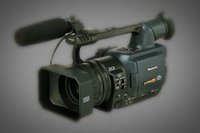 Panasonic HVX-200 If you are making cinematic short films and you are on a budget, this camera is not only the best bang for the buck, it might just be the best. This HD Camcorder is solidly built, compact and user friendly,
Panasonic HVX-200 If you are making cinematic short films and you are on a budget, this camera is not only the best bang for the buck, it might just be the best. This HD Camcorder is solidly built, compact and user friendly,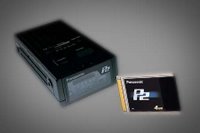 P2 Solid state memory Just imagine, low compression HD footage, no tapes necessary. With a computer hardrive on set, load footage (dailies) into your Non Linear Editor as you shoot. This way only one 4GB P2 card is even necessary. Never have to digitize again!
P2 Solid state memory Just imagine, low compression HD footage, no tapes necessary. With a computer hardrive on set, load footage (dailies) into your Non Linear Editor as you shoot. This way only one 4GB P2 card is even necessary. Never have to digitize again!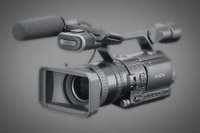 Sony HVR-Z1U If you are shooting clean and crisp documentary style footage, this camera is the winner. Record HDV footage on your normal minidv tapes. If it's anything like Sony's PD-150/170 I bet this thing is amazing in low-light conditions.
Sony HVR-Z1U If you are shooting clean and crisp documentary style footage, this camera is the winner. Record HDV footage on your normal minidv tapes. If it's anything like Sony's PD-150/170 I bet this thing is amazing in low-light conditions.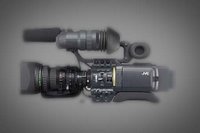 JVC GY-HD200U I don't know the full story on these JVC's yet, but they also redord HDV onto standard minidv tapes. If you happen to have a set of 16mm prime lenses you can attach them to these cameras via an adapter. In which case this camera would be an incredible asset.
JVC GY-HD200U I don't know the full story on these JVC's yet, but they also redord HDV onto standard minidv tapes. If you happen to have a set of 16mm prime lenses you can attach them to these cameras via an adapter. In which case this camera would be an incredible asset.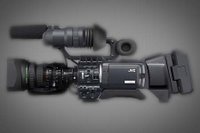 JVC GY-HD250U Very similar to the above camera. You'll have to read the link for the specifics. Sorry, I haven't played with this one yet.
JVC GY-HD250U Very similar to the above camera. You'll have to read the link for the specifics. Sorry, I haven't played with this one yet.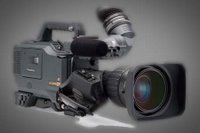
Panasonic AJ HDX900 Um, if you can afford this, over the HVX-200 (shown at top) then, yes, this is the better option. The CCD chips that process the image imformation on a camera like this are going to be larger and therefore capture a more true color representation (i.e. an even higher quality image). Viper Filmstream This is the camera that was used to shoot the film Collateral. It shoots an extremely high resolution progressive frame image. It is comparable to the image captured on a frame of 35mm film (debateable I know). It captures what is called at 4:4:4 resolution. Basically dv video goes through a process called color sampling when it is encoded. If the information about every single pixel were recorded it would give a higher quality image but the file size would be huge. Through compressions i.e. DV, DVCpro, DVCam, HDV, etc., the file sizes of your video is decreased so that your computer can handle the information. Cameras like the Viper FilmStream do not color sample, giving you the highest and truest resolution.
Viper Filmstream This is the camera that was used to shoot the film Collateral. It shoots an extremely high resolution progressive frame image. It is comparable to the image captured on a frame of 35mm film (debateable I know). It captures what is called at 4:4:4 resolution. Basically dv video goes through a process called color sampling when it is encoded. If the information about every single pixel were recorded it would give a higher quality image but the file size would be huge. Through compressions i.e. DV, DVCpro, DVCam, HDV, etc., the file sizes of your video is decreased so that your computer can handle the information. Cameras like the Viper FilmStream do not color sample, giving you the highest and truest resolution. 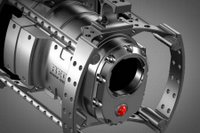 Red One Digital Cinema Camera This camera is being developed by the guy that made Oakley sunglasses. Turns out he is a video buff. Basically it does what the Viper FilmStream camera does. But the Viper is around $100,000 while the Red One Cinema Camera is only $15,000. It is still in the development process, and the lenses come seperately. It's a pretty exciting development nonetheless.
Red One Digital Cinema Camera This camera is being developed by the guy that made Oakley sunglasses. Turns out he is a video buff. Basically it does what the Viper FilmStream camera does. But the Viper is around $100,000 while the Red One Cinema Camera is only $15,000. It is still in the development process, and the lenses come seperately. It's a pretty exciting development nonetheless.
For right now, you can follow the links below each picture if you'd like to read about the differences between each one of these cameras. Stay tuned and I will be posting my own information on them as well. If you ever have a question, please leave a comment. While I can't promise I can give a good answer, I would love to try.
Wednesday, May 03, 2006
NAB 2006 Product Reccomendations
Subscribe to:
Post Comments (Atom)
1 comments:
Thanks for the rant! I fully agree, P2 cards don't hold enough footage. I have to speculate that they will be coming out with bigger cards soon, and prices are sure to drop as well. They might even make an attachment that allows the camera to hold a larger drive. One solution to this problem would be to rent a bunch of P2 cards, if that is possible, so that you won't have to completely stop production every 8 to 16 minutes.
10:41 PMSolid state is definitely the wave of the future though. Thanks for the comment!
Post a Comment